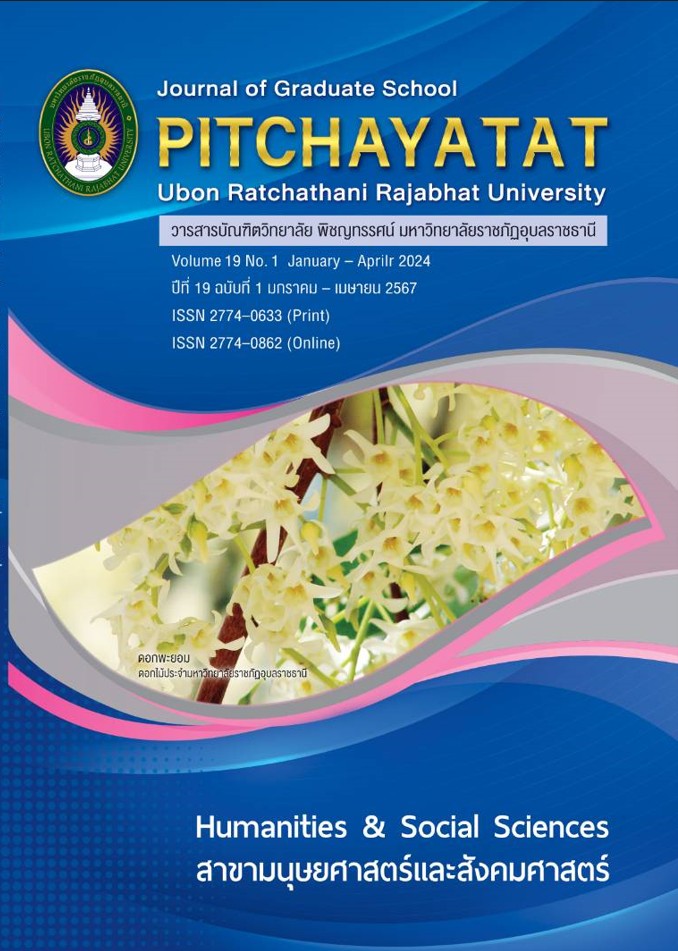ผลของการจัดการเรียนการสอนโดยใช้การออกแบบการเรียนรู้จากการสร้างมโนภาพทางเคมีร่วมกับโมเดล CIPPA ที่มีผลต่อผลสัมฤทธิ์ทางการเรียนวิชาเคมีและความสามารถในการ ให้เหตุผลเชิงวิทยาศาสตร์ของนักเรียนมัธยมศึกษาตอนปลาย โรงเรียนเตรียมอุดมศึกษาภาคเหนือ พิษณุโลก
บทคัดย่อ
การวิจัยนี้มีวัตถุประสงค์เพื่อ 1) เปรียบเทียบผลสัมฤทธิ์ทางการเรียนวิชาเคมีระหว่างนักเรียนที่เรียนด้วยการจัดการเรียนการสอนโดยใช้การออกแบบการเรียนรู้จากการสร้างมโนภาพทางเคมีร่วมกับโมเดล CIPPA กับนักเรียนที่เรียนในรูปแบบจัดการเรียนการสอนแบบปกติ 2) เปรียบเทียบผลสัมฤทธิ์ทางการเรียนวิชาเคมีของนักเรียนที่เรียนด้วยการจัดการเรียนการสอนโดยใช้การออกแบบการเรียนรู้จากการสร้างมโนภาพทางเคมีร่วมกับโมเดล CIPPA กับเกณฑ์ร้อยละ 80 3) เปรียบเทียบความสามารถในการให้เหตุผลเชิงวิทยาศาสตร์ระหว่างนักเรียนที่เรียนด้วยการจัดการเรียนการสอนโดยใช้การออกแบบการเรียนรู้จากการสร้างมโนภาพทางเคมีร่วมกับโมเดล CIPPA กับนักเรียนที่เรียนในรูปแบบจัดการเรียนการสอนแบบปกติ และ 4) เปรียบเทียบความสามารถในการให้เหตุผลเชิงวิทยาศาสตร์ของนักเรียนที่เรียนด้วยการจัดการเรียนการสอนโดยใช้การออกแบบการเรียนรู้จากการสร้างมโนภาพทางเคมีร่วมกับโมเดล CIPPA กับเกณฑ์ร้อยละ 80 ตัวอย่างวิจัย คือ นักเรียนชั้นมัธยมศึกษาปีที่ 4 โรงเรียนเตรียมอุดมศึกษาภาคเหนือ พิษณุโลก ที่ได้จากการเลือกแบบเจาะจง จำนวน 2 ห้องเรียน ได้แก่ ชั้นมัธยมศึกษาปีที่ 4.2 จำนวน 43 คน เป็นกลุ่มทดลอง และชั้นมัธยมศึกษาปีที่ 4.3 จำนวน 42 คน เป็นกลุ่มควบคุม เครื่องมือที่ใช้ ได้แก่แผนการจัดการเรียนการสอนโดยใช้การออกแบบการเรียนรู้จากการสร้างมโนภาพทางเคมีร่วมกับโมเดล CIPPA แผนการจัดการเรียนการสอนแบบปกติ แบบทดสอบวัดผลสัมฤทธิ์ทางการเรียนวิชาเคมี และแบบวัดความสามารถการให้เหตุผลทางวิทยาศาสตร์
ผลการวิจัยพบว่า
- นักเรียนที่เรียนด้วยการจัดการเรียนการสอนโดยใช้การออกแบบการเรียนรู้จากการสร้างมโนภาพทางเคมีร่วมกับโมเดล CIPPA มีผลสัมฤทธิ์ทางการเรียนวิชาเคมีสูงกว่านักเรียนที่เรียนในรูปแบบจัดการเรียนการสอนแบบปกติอย่างมีนัยสำคัญทางสถิติที่ระดับ .05
- นักเรียนที่เรียนด้วยการจัดการเรียนการสอนโดยใช้การออกแบบการเรียนรู้จากการสร้างมโนภาพทางเคมีร่วมกับโมเดล CIPPA มีผลสัมฤทธิ์ทางการเรียนวิชาเคมีสูงกว่าเกณฑ์ร้อยละ 80 อย่างมีนัยสำคัญทางสถิติที่ ระดับ .05
- นักเรียนที่เรียนด้วยการจัดการเรียนการสอนโดยใช้การออกแบบการเรียนรู้จากการสร้างมโนภาพทางเคมีร่วมกับโมเดล CIPPA มีความสามารถในการให้เหตุผลเชิงวิทยาศาสตร์สูงกว่านักเรียนที่เรียนในรูปแบบจัดการเรียนการสอนแบบปกติอย่างมีนัยสำคัญทางสถิติที่ระดับ .05
- นักเรียนที่เรียนด้วยการจัดการเรียนการสอนโดยใช้การออกแบบการเรียนรู้จากการสร้างมโนภาพทางเคมีร่วมกับโมเดล CIPPA มีความสามารถในการให้เหตุผลเชิงวิทยาศาสตร์สูงกว่าเกณฑ์ร้อยละ 80 อย่างมีนัยสำคัญทางสถิติที่ระดับ .05
เอกสารอ้างอิง
Bides, A. V. et al. Scientific reasoning ability of special science class students. Ilocos Sur: Candon National High School Senior High School, 2017.
Boonkong, F. and C. Thamprateep. “The Effects of Learning Activities Management Using the Analogy Approach of Learning Management in the Topic of Rates of Chemical Reactions on Scientific Concepts and Scientific Reasoning for Mathayom Suksa V Students at Lamphraphloeng Pitthayakhom School in Nakhonratchasima Province,” The National Conference & Research Presentation 2016. 3, 1 (June 2016): 668-677.
Chomphunuch, P. and P. Sanna. “Academic Hardiness and the effect of Inquiry-based learning of Scientific reasoning of 10th graders on Cell structure and Cell division,” The 7th NEU National Conference 2020 North Eastern University. 7, 1 (May 2020): 529-538.
Gudyanga, E. and T. Madambi. “Students’ Misconceptions about Bonding and Chemical Structure in Chemistry,” International Journal of Secondary Education. 2, 1 (February 2014): 24-40.
Khammanee, T. Teaching sciences. 5th ed. Bangkok: Chulalongkorn University Press, 2017.
Lor, B. Effect of employing The CIPPA instructional model in organizing learning activities on learning achievement, science process skills and science attitude of prathom suksa five students. Bangkok: Chulalongkorn University, 2002.
McNeill, K. L. and J. Krajcik. “Scientific explanations: Characterizing and evaluating the effects of teachers' instructional practices on student learning,” Journal of Research in Science Teaching. 45, 1 (July 2007): 53-78.
Rinla, C. Effects of instruction using visualization of chemistry learning design on scientific representations and attitude toward learning chemistry of upper secondary school students. Bangkok: Chulalongkorn University, 2016.
Salta, K. and C. Tzougraki. “Attitudes toward chemistry among 11th grade students in high schools in Greece,” Science Education. 88, 4 (April 2004): 535-547.
Schen, M. S. Scientific reasoning skills development in the introductory biology courses for undergraduates. The Degree Doctor of Philosophy in the Graduate School of The Ohio State University, 2007.
Taber, K. S. “Mediating mental models of metals: Acknowledging the priority of the learner's prior learning,” Science Education. 87, 5 (July 2003): 732-758.
Tasker, R. et al. Web Site for General Chemistry-an American Chemical Society Project. New York: WH Freeman & Co. See, 2003.
Tasker, R. and R. Dalton. Visualizing the molecular world–Design, evaluation, and use of animations. In Visualization: Theory and practice in science education. 3rd ed. Netherlands: Springer Dordrecht, 2008.
ดาวน์โหลด
เผยแพร่แล้ว
รูปแบบการอ้างอิง
ฉบับ
ประเภทบทความ
สัญญาอนุญาต
ลิขสิทธิ์ (c) 2024 วารสารบัณฑิตวิทยาลัย พิชญทรรศน์ มหาวิทยาลัยราชภัฏอุบลราชธานี

อนุญาตภายใต้เงื่อนไข Creative Commons Attribution-NonCommercial-NoDerivatives 4.0 International License.
บทความทุกเรื่องได้รับการตรวจความถูกต้องทางวิชาการโดยผู้ทรงคุณวุฒิภายนอกอย่างน้อย 3 คน ความคิดเห็นในวารสารพิชญทรรศน์เป็นความคิดเห็นของผู้นิพนธ์มิใช่ความคิดเห็นของผู้จัดทำ จึงมิใช่ความรับผิดชอบของวารสารพิชญทรรศน์ และบทความในวารสารพิชญทรรศน์สงวนสิทธิ์ตามกฎหมายไทย การจะนำไปเผยแพร่ต้องได้รับอนุญาตเป็นลายลักษณ์อักษรจากกองบรรณาธิการ





